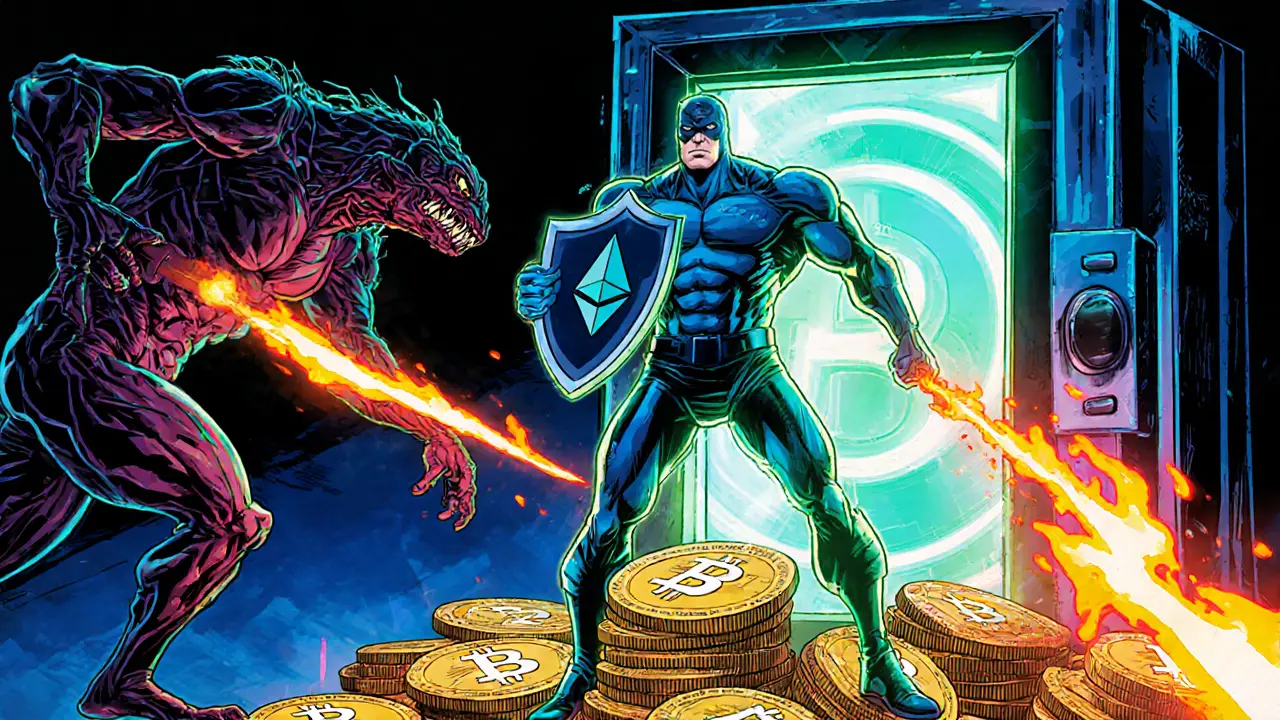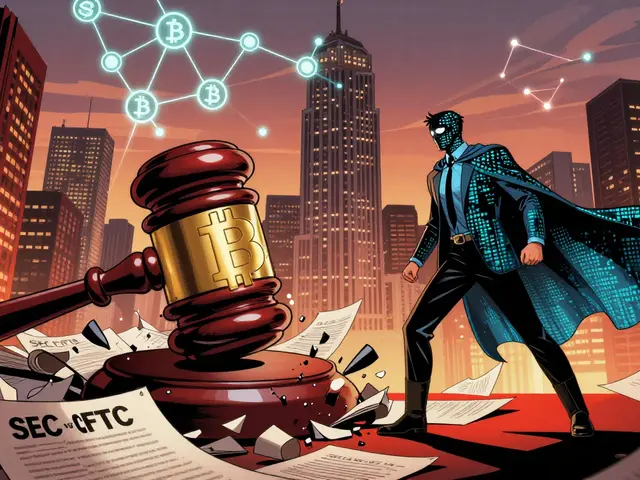How to Protect Against Slashing in Proof‑of‑Stake Blockchains
Slashing Protection Calculator
Penalty Summary
Slashing Penalties Overview
| Infraction | Typical Penalty | Impact on Stake |
|---|---|---|
| Double signing | Up to 5% of total stake | Immediate loss plus removal from validator set |
| Extended downtime (multiple missed slots) | ~0.1% per missed slot | Cumulative loss; may trigger removal if repeated |
| Minor protocol violation | Negligible (often < 0.01%) | Usually a warning; no removal |
When you hear the term slashing protection is a set of technical and operational safeguards that prevent a validator in a Proof‑of‑Stake blockchain from being penalized through slashing. In plain English, it’s the safety net that stops a small mistake-or a malicious act-from wiping out a chunk of your staked tokens. If you’re planning to stake, understand the risk, or run a validator service, knowing how to stay slashing‑free is essential.
What exactly is slashing and why does it matter?
At its core, slashing is an economic penalty built into Proof‑of‑Stake (PoS) protocols to enforce honest behavior among validators. Two main infractions trigger the fire‑hose:
- Double signing: a validator signs two different blocks for the same slot or signs conflicting messages. The network sees this as a double‑spend attempt and may confiscate up to 5% of the validator’s stake.
- Validator downtime: the node simply misses its turn to propose or attest to a block. While less severe, repeated downtime can cost around 0.1% of the stake for each missed slot.
Beyond the direct loss, slashing also wipes the validator’s ID, forcing it out of the active set. That means you lose future rewards and must re‑stake if you want to come back.
How the ecosystem keeps validators honest
PoS networks rely on a community of whistleblowers other validators that submit evidence of wrongdoing to the chain. When a violation is reported, the offending validator is penalized and the reporter receives a fraction of the seized tokens. This creates a built‑in bounty system that encourages continuous monitoring.
The design principle is simple: make dishonest actions economically unviable. By raising the cost of corruption, the protocol protects itself without needing heavy technical barriers.
Key principles for effective slashing protection
Industry leaders like Consensys Staking a major staking service that builds slashing‑prevention into its infrastructure and CubeSigner a hardware‑backed key manager designed to eliminate duplicate keys have converged on a few non‑negotiable rules:
- Never reuse the same validator key in multiple locations. Duplicate keys are the single biggest cause of accidental double signing.
- Generate each key from a unique seed phrase. This guarantees cryptographic separation.
- Track every signature a validator produces. An anti‑slashing service must compare new signing requests against the historical log.
- Store keys in tamper‑proof hardware. Solutions like AWS Nitro Enclaves or dedicated HSMs keep the private key sealed away from any software that could leak it.
Following these rules dramatically reduces the odds of an accidental slash-often to near zero.
Technical toolkit: anti‑slashing solutions you can use today
Below is a quick snapshot of the most common tools and services that implement the rules above.
- Web3 Signer - an open‑source remote signer used by Consensys. It records each signature and refuses to sign anything that would conflict with a prior message.
- CubeSigner - stores keys inside HSM‑sealed Nitro Enclaves, then runs an “anti‑slasher” component that checks every request against a local history database.
- EIP‑3076 - Ethereum’s specification for an Active Validation Service (AVS) a standard interface that lets validators query anti‑slashing logic before signing. Many PoS chains are adopting similar specs.
- Secure Staking Alliance - a consortium that publishes best‑practice guides and reference implementations for anti‑slashing across multiple networks.
These tools are not mutually exclusive; most professional operators run a remote signer (Web3 Signer) inside a hardened VM and keep the actual key inside a Nitro Enclave‑backed HSM, creating a defense‑in‑depth stack.

Step‑by‑step checklist for setting up slashing protection
Whether you’re a solo staker or an enterprise‑grade operator, this checklist walks you through the essential actions.
- Generate a fresh seed phrase for each validator you intend to run.
- Import the seed into a hardware security module (HSM) or an AWS Nitro Enclave‑based key manager.
- Configure a remote signer (e.g., Web3 Signer) to fetch the public key from the HSM and expose a signing API.
- Enable the anti‑slashing middleware (EIP‑3076‑compatible) in the remote signer. It will store every signed message in a local DB.
- Run a single validator client instance per key. If you need redundancy, use a hot‑standby that shares the same HSM but never signs simultaneously.
- Set up monitoring alerts for:
- Missed slots (downtime)
- Duplicate signing attempts (should never happen with a proper anti‑slasher)
- HSM health and enclave uptime
- Periodically export the signed‑message log and verify it against the chain’s slash‑filtering tools (most networks provide a "check‑slashing" CLI).
- Keep your software up‑to‑date. Protocol upgrades often adjust slashing thresholds.
Following this list will give you a solid base. The one thing that most newcomers forget is step5: never run two validators with the same key at the same time. It’s tempting to have a backup, but the cost of an accidental double‑sign far outweighs any uptime gain.
Understanding the penalties: a quick comparison
| Infraction | Typical Penalty | Impact on Stake |
|---|---|---|
| Double signing | Up to 5% of total stake | Immediate loss plus removal from validator set |
| Extended downtime (multiple missed slots) | ~0.1% per missed slot | Cumulative loss; may trigger removal if repeated |
| Minor protocol violation (e.g., malformed attestations) | Negligible (often < 0.01%) | Usually a warning; no removal |
Effective slashing protection keeps you out of the first two rows. The third row is mostly covered by standard protocol testing.
Real‑world stories: when protection failed and what we learned
In 2023 a mid‑size staking service attempted to run a hot‑standby validator by simply cloning the original key file across two servers. A network glitch caused the two instances to sign the same slot at slightly different times, resulting in a double‑sign incident that stripped 4.7% of the pooled stake. The service recovered financially, but its reputation took a hit and several delegators pulled out.
The lesson? Redundancy is great, but only when it’s built on a slashing‑aware design: share the key via an HSM, not a duplicated keystore.
Future trends: where slashing protection is headed
As PoS adoption expands, we’re seeing two big movements:
- Standardization across chains. Projects like the Secure Staking Alliance are pushing a unified “anti‑slashing API” that works on Ethereum, Cosmos, Polkadot, and emerging L2s. One interface, many networks.
- Lowering the barrier for small validators. Managed services are offering “plug‑and‑play” hardware wallets that embed anti‑slashing logic, letting hobbyists stake safely without a PhD in cryptography.
These trends mean the next wave of slashing protection will be more interoperable and more accessible, but the core principles-unique keys, hardware isolation, and signature history-will remain unchanged.
Quick reference: anti‑slashing decision tree
Use this simple flowchart when planning your setup:
- Do you control the validator key directly?
Yes → Proceed to step2.
No → Choose a managed service that guarantees key uniqueness. - Is your key stored in hardware (HSM/Nitro Enclave)?
Yes → Go to step3.
No → Migrate to hardware to prevent extraction. - Do you run a remote signer with anti‑slashing middleware?
Yes → Enable monitoring and you’re good.
No → Deploy Web3 Signer or CubeSigner.
If you ever hit a red flag in monitoring, pause the validator, investigate the log, and submit a “check‑slashing” query before restarting.

Frequently Asked Questions
What is the difference between double signing and downtime?
Double signing means a validator produces two conflicting signatures for the same slot, which the network treats as a malicious attempt. Downtime is simply missing the chance to sign at all. The former carries a heavy penalty (up to 5% of stake) while the latter incurs a small fee (≈0.1% per missed slot).
Can I use the same seed phrase for multiple validators?
No. Reusing a seed phrase creates identical validator keys, which is the most common cause of accidental double signing. Generate a fresh phrase for each validator.
How does a remote signer stop a slashable message?
Before signing, the remote signer checks the incoming message against a local database of all previous signatures. If the new request would conflict (same epoch, different block hash), the signer refuses to sign and returns an error, preventing the slash.
Do I need an HSM if I’m only staking a small amount?
While not mandatory, using hardware‑backed storage dramatically lowers the risk of key leakage and duplicate‑key mishaps. Many cloud providers now offer low‑cost enclave options that make HSM‑level security accessible to smaller stakers.
What should I do if I’m notified of a potential slash?
First, pause the validator to stop further signing. Then, inspect the local signature log to see if a conflicting message was produced. Run the chain’s official "check‑slashing" tool with the offending slot number. If the tool confirms no violation, you can safely restart; otherwise, accept the penalty and investigate why the conflict occurred.








When one examines the staking landscape, it becomes evident that slashing functions not merely as a punitive mechanism, but as a structural deterrent; consequently, validators must adopt a multifaceted risk‑mitigation strategy, incorporating redundancy, monitoring, and timely response protocols. Moreover, the allocation of collateral should be diversified across multiple validators, thereby reducing exposure to any single point of failure; this approach, while increasing operational complexity, aligns with best‑practice security postures. Finally, continuous education and simulation drills are indispensable, as they reinforce preparedness against both inadvertent downtime and malicious double‑signing attempts.
The whole system is a façade, designed by hidden entities to siphon off capital from diligent participants; think about the undisclosed code pathways that could be weaponized at any moment.
Imagine a validator set that functions like a tightly knit community, each node watching the others’ heartbeat, ready to step in the moment one falters; in such an ecosystem, slashing is not a random strike but a communal safeguard. The first line of defense is robust key management, ensuring that signing keys never wander into insecure environments, because a single leak can trigger a double‑signing catastrophe. Next, implement a diversified hardware strategy-use multiple physical machines, perhaps even spread across different geographic regions, so that network partitions or power outages affect only a slice of the stake. Monitoring tools must be calibrated to emit alerts the instant a validator misses a slot, giving operators a narrow window-often measured in seconds-to restart services before penalties accrue. On top of that, integrate automated failover scripts that can rebroadcast missed attestations, effectively masking brief downtimes from the protocol’s perspective. Education plays a silent yet pivotal role: validators should routinely rehearse emergency drills, simulating both network failures and accidental key reuse, to internalize swift recovery actions. Furthermore, stake delegation can be leveraged wisely; delegators spread across many validators dilute the risk, while still earning rewards, embodying the principle of risk‑sharing. However, delegation introduces its own considerations, such as the need to vet operators for adherence to slashing‑avoidance best practices, lest a rogue validator bring down the pooled assets. In practice, one should also monitor the protocol’s governance proposals, because changes to slashing thresholds or penalty calculations can shift the risk landscape overnight. Keeping abreast of community discussions on forums and developer chats ensures that you are not caught off‑guard by a sudden policy shift. Additionally, maintaining a small reserve of liquid ETH, distinct from the staked amount, provides a financial cushion to absorb any unexpected penalties without jeopardizing long‑term staking goals. When the inevitable hardware glitch occurs, this buffer can be used to re‑stake quickly, restoring the validator’s position in the active set. Security audits of your staking infrastructure, preferably conducted by third‑party experts, uncover hidden vulnerabilities that internal teams might overlook. Regularly rotating keys, employing hardware security modules, and isolating signing operations within air‑gapped environments collectively lower the attack surface. Finally, remember that the psychological component matters: stress can lead to mistakes, so fostering a calm operational environment, perhaps by using shift rotations and clear SOPs, reduces human error that could trigger slashing. By weaving together these technical, procedural, and human factors, validators build a resilient shield against the ever‑present specter of slashing, turning a potential existential threat into a manageable operational risk.
While the tables provide a clear snapshot of typical penalties, they don't capture the nuanced impact on a validator's reputation; repeated minor infractions can erode trust long before any financial loss becomes significant.
Honestly, the whole obsession with slashing is overblown; many validators simply accept the occasional minor penalty as the cost of participation, and the market self‑corrects without any heavy‑handed intervention.
Oh sure, because the mysterious overlords are definitely lurking behind every missing slot, ready to pounce the moment you blink.
Set up automated alerts, keep keys offline, and diversify nodes-basic but effective.
That's the golden rule.
From a broader perspective, slashing can be viewed as an evolutionary pressure, nudging the network toward higher reliability and encouraging participants to develop more robust infrastructures.
Exactly! 🌱 The pressure makes us level up, and the community thrives when we all stay vigilant. 🚀
Contemplating the paradox of security, one realizes that the very mechanisms designed to protect the network can, paradoxically, become sources of anxiety for its custodians; slashing epitomizes this duality, serving both as a deterrent and as a specter haunting the validator's nightly thoughts. When the protocol imposes a 5% reduction for double signing, it does more than merely penalize; it broadcasts a moral lesson to the entire ecosystem, reaffirming the sanctity of honest participation. Yet, the human element introduces unpredictability-network latency, hardware glitches, and even simple misconfigurations can unintentionally trigger the same punitive response intended for malicious actors. This convergence of technical rigor and human frailty demands a philosophy of preparedness that transcends rote checklists, urging operators to adopt a mindset of continuous adaptation. In practice, this translates to layered defenses: immutable configuration, real‑time telemetry, and a culture of peer review where every signing key is scrutinized before deployment. Moreover, the cost of slashing is not solely measured in ether; it also erodes confidence, potentially influencing delegation decisions and the long‑term health of the network. Therefore, embracing slashing as a learning opportunity, rather than a purely punitive endpoint, can transform setbacks into catalysts for systemic improvement.
Great points-keeping a disciplined process and regular peer reviews really does turn those setbacks into growth opportunities.
Stop sugar‑coating it; if you’re not monitoring your validator 24/7, you’re willingly inviting slashing and should accept the consequences.
Agreed, consistent monitoring is non‑negotiable; setting up redundant alerts and backup nodes can save you from avoidable losses.
In the grand theatre of blockchain, slashing is the tragic climax that haunts every validator, a reminder that triumph is forever shadowed by the possibility of downfall.
True, the drama adds intensity, but practical steps like key rotation and diversified staking reduce the odds of that tragic ending.
Oh joy, another reminder that the blockchain will punish you for a missed heartbeat-because nothing says “secure” like relentless, unforgiving penalties.
While the sarcasm is noted, the reality is that excessive penalty structures can deter newcomers and stifle decentralization.
At the end of the day, sharing knowledge about slashing protection helps everyone feel more confident and keeps the network healthy.
Absolutely! 😊 Let’s keep the conversation friendly and supportive-together we’re stronger. 💪